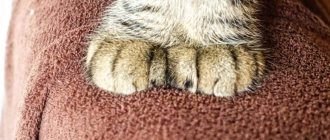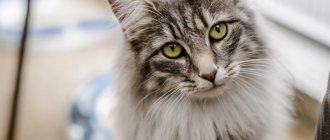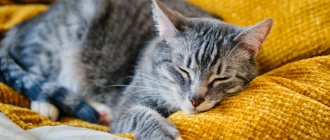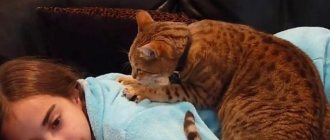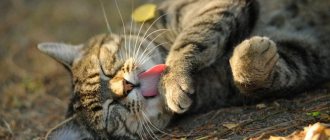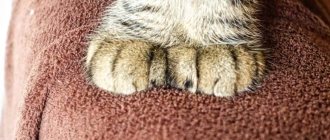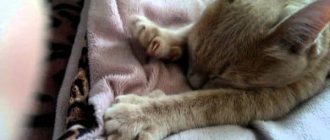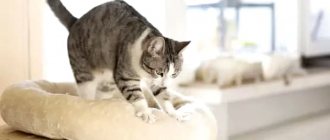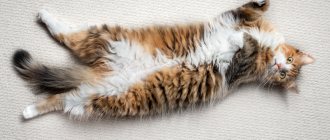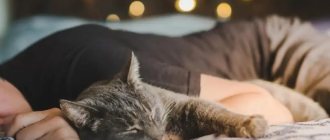Many people get cats to play with them and not feel lonely. At the same time, many people do not think about how much effort they need to take care of them. We are talking about feeding, haircut, bathing, and various hygiene procedures. But in return, owners can receive much more - the love and care of their pet. Sometimes this is expressed in the form of a cat touching a person’s body or clothing with its soft paws. But people do not always understand the reasons for such behavior and may even scold the cat for it. Therefore, next we will talk about why cats knead a person’s paws and how you can get rid of discomfort (if any).
When the phenomenon is observed
The owner most often observes the peculiar behavior of a domestic cat when the animal is in a peaceful and calm state. At this moment, the pet may purr. Some cats perform the ritual without releasing their claws.
Other individuals can crush the soft surface, extending their claws to their full length. At the same time, the animal looks concentrated, the reaction to external stimuli becomes minimal. Some owners compare this state of their pet to nirvana.
Many cat breeders note that the cat ritual usually takes place on a soft and pliable surface: a blanket, a mattress, the owner’s lap. A hard surface is not suitable for such purposes. Often the “milk step” is used in relation to a soft toy.
Most often, a cat crushes a soft object with its paws when it is about to rest or sleep. Expectant mothers begin to prepare the nest for childbirth and offspring, often before an important event they begin to knead the blanket with their paws. Pets love to perform such a mysterious action when they are on the lap of their beloved owner. Fans of cats note that a cat performs such a ritual only with its owner; such affection is not available to a stranger.
To learn about what a “milk step” is in cats, watch this video:
[custom_ads_shortcode1]
Romantic version
Happy owners of meowing and purring pets value them for the coziness and comfort they bring to their home.
Those moments are especially blissful and peaceful when a pet, in a fit of tenderness and devotion, jumps into the owner’s arms and methodically tramples with its front paws. Except, of course, for situations when an animal uses its claws, having forgotten itself and become carried away by the “massage” process. The most romantic and emotional cat owners explain these habits of their pets by their sincere affection and expression of gratitude and love to their owner. This version is the most difficult to confirm, since reliable methods for studying the emotions of cats (if they exist) have not yet been invented. But besides this version, there are many more options for explaining the behavior of cat “masseurs”.
Probable Causes
Experts in the field of animal psychology identify several reasons why cats knead their paws. This ritual has the following explanations and theories:
It is for this reason that cat breeders call this ritual the “milk step.” Owners often notice that the kitten not only wiggles its paws, but also purrs contentedly and even drools with pleasure. This theory is supported by the fact that artificially fed pets are not capable of the “milk step”.
- One of the reasons why cats paw is their natural instincts. Being once wild predators, animals carefully prepared places for rest and overnight: they trampled down hard grass, making the nest cozy and soft. In the wild, representatives of the cat family use grass and leaves to make a nest. To make your sleeping area comfortable and safe, it needs to be put in order. The most convenient way to do this is to crush objects with your paws.
The desire to equip one’s territory, a place to rest and sleep, is also characteristic of modern domestic couch potatoes. And although most pets live in comfortable conditions, nevertheless, they have not lost the ancient instinct of their wild ancestors. In addition, the cat often crushes soft objects with its paws, arranging a nest for birth and future offspring. Often this behavior is a sign of impending labor.
- Hunting instinct. Some experts believe that domestic cats knead a soft surface, obeying the ancient hunting instinct. Predators by nature, pets have not lost the ancient skills of this skill. Their wild counterparts, before jumping on the prey, crush the surface with their paws, testing it for stability and hardness. It is important for a predator that at a crucial moment a branch does not snap under its paw. Fluffy couch potatoes have not lost their natural instincts, but they do not always use them for their intended purpose.
- Territorial version. Some zoologists are inclined to believe that the reason why cats crush their owners' paws is their desire to mark their territory. There are specific glands on the pads of cats' paws, with the help of which they identify their possessions and territory.
Considering its beloved owner to be its property, the animal leaves its scent on his body, making it clear to other individuals that they can no longer have the right to the owner’s attention. Thus, the ritual serves as a kind of marker to mark one’s property and possessions.
- Psychological release. The psycho-emotional tension or stress accumulated by the pet requires release. Some animal psychologists, not without reason, believe that the reason why cats knead the blanket with their paws is self-soothing. At the same time, the animal practically disconnects from the outside world and focuses on its internal sensations. Monotonous paw movements and purring help calm the pet.
This point of view is supported by the fact that during the “milk step” the cat’s body produces endorphins - specific substances, hormones of happiness. They reduce anxiety and fear in pets.
- Other factors. Experienced breeders believe that the reason for the cat ritual is a high degree of trust and love for its owner. Many cat fans believe that animals perform such a ritual for a healing purpose - they treat their owner from various ailments, taking away negative energy.
Another reason why cats massage their paws is sexual behavior. As a rule, in the spring, with increasing daylight hours, the production of sex hormones increases, which in some individuals is accompanied by a “milk step”. The variety of theories, versions and guesses regarding a peculiar ritual inherent only to representatives of the feline family once again testifies to the mystery and enigma of domestic cats.
None And here is more information about how to remove a cat from a tree yourself and with the help of special services.
[custom_ads_shortcode2]
Scientific explanation
- Instinct from childhood
When a cat gives birth to many kittens, her milk may not be enough. Then the babies press their paws on their mother’s stomach to get a drink. So it is likely that this is a habit from childhood. How do humans sleep in the fetal position (and cats too).
- Love for the owner
If an animal is taken away from its mother early, then this behavior is often observed towards the owner. This sign speaks of the closeness between a person and a four-legged pet. Also, a cat can often move its paws through a rug or blanket and purr.
- Genetic memory
Cats have long been domesticated animals, but their instincts are still preserved from ancient times, when they needed to survive in the wild and make their own homes. With the help of trampling, they took the grass and made their sleeping place more comfortable. Perhaps the cat is trampling in order to lie down and rest more comfortably.
The cat tramples with its paws
- Territory designation
Zoologists pay attention to the fact that cats have sweat glands on their paw pads. They produce sweat with a unique odor that humans cannot smell. But cats sense each other's signals perfectly. So this may be a way of “marking territory.”
- Good mood
Cats perfectly sense the emotional state, including the mood of their owner. If a person close to a cat is upset, she can start giving him a massage that causes the release of endorphins. The cat enjoys itself and supports its owner in difficult times.
- Mating season
Sometimes moving its paws can be a sign that your cat has entered mating season, which causes pets to behave completely differently. And if there is no potential partner nearby, the cat begins to be distracted by the owner. In such situations, you need to wait until the cat calms down, or find her a soul mate.
Cats trample with their front paws
Should I be scolded for such behavior?
Understanding why cats knead the blanket with their paws, the owner should under no circumstances punish the pet for displaying natural instincts. You should be understanding of the complex and peculiar behavior of the cat. Negative emotions, irritating intonations, and being thrown off your knees during the “milk step” can lead to stress and the development of a negative psycho-emotional state. The animal will stop trusting the person and will withdraw from communication with him.
The owner may not like the fact that the cat crumples his body due to the fact that some individuals can release their claws and injure him. In this case, it is advisable to keep a thick towel or small blanket nearby to lay on your lap. This will protect the owner from injury if the cat releases its claws.
You can stop the unwanted action by lightly pressing the cat against a soft surface. She will settle down and calm down. Stroking and gentle intonations will calm the pet, and it will stop kneading the owner’s paws.
The unusual behavior of domestic cats in the form of trampling in one place has a variety of reasons. Most often, a kind of ritual is associated with the natural instincts and psycho-emotional state of the animal. An attentive and affectionate attitude towards the pet at this moment is the only thing required from a loving owner.
Cats are amazing creatures. Despite the fact that they have lived next to humans for many millennia, their behavior sometimes raises questions in us. Many owners of such pets are interested in why cats trample.
What is the reason for these animals moving their paws? What does this behavior mean? How should you behave when a cat crushes its owner or the sofa with its paws?
[custom_ads_shortcode3]
What should and should not be done?
Touching and kneading the owner with its paws is a natural behavior for every furry pet. You can’t blame him for this, just like:
- Punish;
- Use physical force;
- Limit your attention.
If a cat tramples with its paws and at the same time releases claws that scratch the skin or tear clothes, the owners can use the following techniques:
- It is necessary to trim the nails, but not too short;
- You can pet your pet;
- You can place a thick blanket under the cat's paws;
- It is worth lightly pressing on the front paws, which will force the pet to remove its claws;
- You can distract your pet's attention by showing his favorite toy;
- It is recommended to lay the cat on its side, stroking its head.
Massaging and purring a cat is the best manifestation of his attention and love. If you decide to punish your pet for this, you risk ruining your relationship with him forever and causing his aggression.
Expression of satisfaction
People to express love for their cats:
- petting pets;
- scratch behind the ear or under the chin;
- speak kindly to animals;
- play;
- treat pets with treats.
Cats, experiencing true pleasure from their owner's attentions, try to express gratitude and love to their owner. The only way they can express their feelings is by moving their paws. This is how the pet “tells” the owner that he loves him, trusts him and enjoys his company.
[custom_ads_shortcode3]
Misconceptions
Sometimes “experts” in cat psychology explain their behavior by saying that by massaging something or someone, they receive psychological relief, and endorphins are produced in the body. But, excuse me, when a person experiences pleasure from food, affection or sex, doesn’t he release a hormone of joy? This version puts the cart before the horse and confuses effect and cause. The very act of moving one's paws is caused by pleasant feelings and joy, and not the other way around. With the same success it can be argued that Barsik purrs in order to become happy.
Don’t believe it when, when answering the question why cats knead us with their paws and purr, they tell you about therapeutic massage. Yes, the living warmth of an affectionate cat heals, relieves spasms, even nervous tension. Yes, she often chooses sore spots with elevated temperatures to snuggle and warm up. But Murkas do their “massage” not on the owner’s problem areas, but where it is convenient for them.
Observing cats at home, we notice that they, sensitively sensing and choosing warm places, are completely indifferent to the softness of the sleeping place. Therefore, the hypothesis that they trample the future rookery to make it softer can also not be considered.
An interesting experiment was unintentionally and accidentally carried out in one of the nurseries. A rare breed was being bred, and the mother cat refused to feed her offspring. Six blind newborn kittens were divided into two groups. The three were fed by a diligent laboratory assistant. She wrapped each kitten in a napkin so that it wouldn’t get dirty, picked it up and fed it milk from a pacifier.
The second group was raised by a trainee. He simply placed three bottles sideways on the bottom of the box and went about his business. After two months, a difference in the physical development of the pets became noticeable. Those babies who received food without making any special effort, without moving their paws, without massaging the bottles, turned out to be non-viable. The sad end of the experiment showed the benefit of the reflex. Among other things, it strengthens the kitten’s muscles and develops it physically.
Establishment of “ownership rights” to the owner or mistress
If a cat crushes a person with its paws, this probably means that this is how he establishes his rights to him. The fact is that on the pads of a cat's paws there are sweat glands, with the help of secretions from which these animals leave odorous marks. The beloved owner becomes an object protected by the cat from those who wish to encroach on him. Being marked as a pet is a special honor, because from now on he will give all the affection and love to the one to whom he has established ownership.
[custom_ads_shortcode1]
Indications for massage procedures
The kitten feels the beneficial effects of massage movements from birth; postpartum licking by a cat tones the baby, stimulates processes in the body, and encourages action. Regular massaging of the abdomen is necessary for the baby's digestion. Massage of the tummy and body is mandatory for kittens left without a mother.
Old animals also need additional stress and exercise. Kneading exercises improve the quality and duration of their life, relieve pain, and stimulate the functioning of the kidneys and intestines.
Very active and sedentary animals benefit from massage to normalize muscle tone.
Massage is especially indicated for conditions such as:
- paralysis and paresis after falls and accidents;
- injuries (rehabilitation);
- some congenital and genetic diseases;
- restriction of movements for a long time for various reasons;
- joint dysplasia in large breeds of cats.
Therapeutic massage session
Cats are not only cute pets, but also healers. They are able to detect illness in the owner. Cats often detect diseases long before humans know about them.
When the animals settle down on their owners, they massage them in an attempt to heal them on their own. In search of an answer to the question of why cats lie on their owner’s body and persistently trample it with their paws, it would be a good idea to be examined by a doctor.
There may be no reason to worry, but it still doesn't hurt to get checked. If the diagnosis does not reveal any abnormalities in the functioning of the internal organs, there will be no harm from a cat massage, because by massaging one or another part of the owner’s body, the cat-stomper stimulates blood flow, which has a beneficial effect on the condition of the tissues.
Some people believe that trampling a cat on the owner's body is a sign of troubles related to his health. You should not take this sign seriously, because, as you know, thoughts are material, and if you persistently think about something, it will come true. If a pet often sits in the same place and begins to knead it, this is just a reason to think once again about its health, but not a reason for serious worries.
[custom_ads_shortcode2]
Children's habit
You've probably noticed that when a cat massages a person, for some reason it purrs, squints and shows obvious pleasure. The fact is that the natural instincts inherent in cats remain with them throughout their lives.
In kittens, trampling with their paws is associated with receiving milk from the mother (lactation is enhanced by light pressure on the nipple area), and this, in addition to satiation, brings pleasure and joy of communication.
As pets grow older, their actions express trust in a person, associating him with his mother, in whose company he felt unusually calm and safe.
What canned food tastes best for cats?
RESEARCH ATTENTION! You and your cat can take part in it! If you live in Moscow or the Moscow region and are ready to regularly observe how and how much your cat eats, and also remember to write it all down, you will receive FREE SET OF WET FOOD.
Project for 3–4 months. Organizer - Petkorm LLC.
Cat lovers know that sometimes a cat begins to trample its owner or a toy with its paws, while its eyes are closed and it purrs loudly. Sometimes cats trample each other in this way. Not everyone understands why a cat tramples you with its paws and behaves this way? What is the meaning of this cat behavior? Why does a cat massage with its paws and why does it give it pleasure, because it is quite obvious that your cat is very happy at the same time.
Everything is very simple. This behavior of a cat is easily explained and is the norm for a cat. The owner should know about this.
Why do cats trample us with their paws?
From birth, instincts govern the behavior of a living creature. Kitten activity is no exception. Immediately after birth, the instinct of a newborn animal makes it look for its mother. A blind newborn kitten finds milk by smell. From this moment his life begins outside the womb. Now he must feed himself and gradually learn to be independent. But for now, during the first weeks of its life, the kitten is under the protection of its mother. A good cat is very attentive to her children.
It must be said that the process of obtaining food gives the kitten great pleasure, although it forces him to work hard. A well-developed sucking reflex allows a healthy kitten to quickly receive warm, optimally suited mother's cat milk. In order to quickly get enough and overcome the resistance of the mother's flesh, the kitten instinctively begins to massage the mother's belly, thus receiving more milk.
The most active kittens spread their paws wide and alternately press strongly with their front paws on the mother's stomach. This behavior is accompanied by faster milk production, which gives the kitten great pleasure. In the future, this relationship: massage with paws - receiving pleasure, is firmly fixed in the kitten’s mind. As cats grow, the habit of trampling their paws does not go away. On the contrary, they happily massage you with their paws, trample on your favorite soft blanket, closing their eyes and purring loudly.
Milky step
This behavior of cats is called the “milk step”, i.e. an instinct established from the moment of birth, when stomping helped the kitten to receive mother's milk. The milk step lasts for a cat's entire life. Cats love to massage their beloved owner, or a soft toy, or their playmate if there are several animals in the house.
The cat's milk step is a special form of confidential communication between the owner and his pet.
If the cat trusts you, he will trample you with his paws, purring enthusiastically. This behavior is not always understandable to cat owners. Some people don't like it. This is due to the fact that some cats like to massage their owner's chest or neck with their paws. At the same time, they release their claws and leave marks and even scratches on the delicate human skin. But you should not scold a cat for showing love. If the cat is practicing the milk step on your skin, then at this moment he needs to be carefully moved to a blanket or the arm of the sofa, where he can calmly continue his trampling and will not harm you. At the same time, the cat gets great pleasure, you should not interfere with this, much less scold the cat for taking a milky step. At this moment, he feels like the same little and beloved mother’s kitten, who is fed, satisfied and completely protected from the vicissitudes of fate.
Love your cat correctly, allow him to show his natural instincts, including the milky step. A cat that is scolded for trampling may become nervous and aggressive. Such a cat will stop trusting you if you pull him back when he is stomping around with his eyes closed. The milk step for a cat is a kind of psychological release. A cat can practice the milk step several times a day. This is considered normal and does not require adjustment. Some cats love to climb into their owner's arms and stomp on his stomach or chest. Most owners are delighted with this display of love and happily hug and stroke their cat while it stomps and purrs. This cat is truly happy. He knows that he is loved and appreciated, and calmly shows his owner that he can give him pleasure.
At the same time, there are cats that do not have a milk step. This may be due to the artificial feeding of the kitten or to its psychological characteristics. Just as there are cats that do not purr, there are also those that do not remember the milk step and do not trample their owner. This is also normal behavior for your cat. All animals, like people, are individuals. You need to respect their habits, know the peculiarities of cat behavior and not make unforgivable mistakes in their maintenance. A cat whose voice is raised, pushed and kicked will be nervous and will begin to defend itself, showing aggression and doing things that will be unpleasant to its owner. But a cat’s misbehavior is the result of a misunderstanding by its owner. That is why, before getting a cat, you need to learn more about its psychology and the characteristics of a particular cat breed.
By the way, there is an opinion that when a cat tramples you with its paws and purrs, you also calm down and your worldview becomes more harmonious. For example, in Britain, there is even a service, communication with a cat for a fee, when a city resident is brought a good, calm, sociable cat, which actually, according to this agreement, works for the customer as a cat: she purrs, tramples him with her paws, talks to him as best she can, thus most calming and putting him in a favorable mood. At this time, thoughts are organized, a person begins to treat everything more thoughtfully and calmly.
A person needs a cat to work as a cat and help relieve the negative consequences of an urbanized lifestyle. Affectionate, trusting cats are an excellent cure for stress. At the same time, a cat is always a hot living heating pad that will be next to you as soon as you lie down. Love your cat, pamper her, pet her and pick her up. Then both you and your cat will be healthy and happy.
Why does a pet move its paws and purr on the bed or sofa?
These animals do not always choose their owners as objects for pawing. You can often notice that a cat climbs onto a bed or sofa and crumples a blanket or bedspread with its paws. Why is she doing this?
There may be several reasons why cats stomp on the bed. This is probably how pets prepare a place to rest, relieve emotional stress, realize sexual instinct, or leave marks.
[custom_ads_shortcode3]
Why do cats knead blankets with their paws?
It’s not uncommon for owners to notice how their pets actively trample the blanket with their paws before falling soundly asleep on it. This legitimately raises the question of why cats knead blankets with their paws. This behavior is not accidental and is caused by instincts that are inherent in the animal by nature. There are several explanations for this feature that the cat demonstrates. Knowing them, the owner will better understand his four-legged pet and will be able to establish especially close contact with him. Furry pets crumple things for various reasons.
Preparing a place to rest
Instincts can explain why many cats stomp on the bed before dozing off. The wild ancestors of these animals trampled down grass and leaves before settling down to rest. So they prepared their bedding and checked whether the rookery was comfortable for sleeping.
Pets, who do not need to prepare their own place to rest, do it instinctively. Before falling asleep, many of them trample down the blanket or bedspread.
[custom_ads_shortcode1]
Indications for the procedure
Cats normally defecate once a day. Animals over 7 years old go to the toilet approximately once every 2 days. If there is no bowel movement for more than 3 days, the cat is constipated.
Typical symptoms:
- restless behavior;
- lethargy;
- refusal of food;
- bloating.
When constipated, the pet sits in the litter box and strains, but does not defecate. Sometimes dry and hard feces are passed in small quantities. However, this does not solve the problem.
You can help your pet yourself. Massage during constipation improves the functioning of the gastrointestinal tract, increases the elasticity of the walls and enhances intestinal motility, which stimulates the release of feces.
Important. If measures are not taken, the body will no longer cope with decay products, the load on the heart will increase, and the functioning of the liver and kidneys will worsen. All this leads to serious complications, including death.
All this leads to serious complications, including death.
Massage is performed for the following problems:
- Constipation due to stress. If the cause is eliminated in a timely manner, massage will normalize bowel movements without the use of medications.
- Chronic constipation. Stool disorders will appear much less frequently. It will be possible to reduce the dosage of medications or stop taking them altogether.
- Constipation in a cat due to a sedentary lifestyle. Typically seen in older animals who become less active.
- Constipation due to changes in diet or poor diet. Difficulty defecating is caused by insufficient fiber intake or a sudden change in food.
- Constipation in obesity. In overweight cats, metabolic processes slow down, which leads to the appearance of dry feces and untimely bowel movements.
It is useful to do massage after birth if the cat has no complications and is in satisfactory condition. The procedure speeds up the recovery of the body and prevents the occurrence of mastitis and other diseases.
If, in addition to constipation, your cat has a fever (above 39.5°C) and vomiting, you should immediately contact your veterinarian. Most likely, she has some serious illness.
Massage is a safe and effective procedure that acts in several directions at once:
- strengthens and tones the abdominal muscles;
- stimulates the movement of feces;
- activates lymph flow and blood circulation;
- relieves pain;
- eliminates spasms;
- reduces gas formation.
Massage is useful even if there is no constipation. It helps to establish a trusting relationship with your pet. Tactile contact brings people closer together and relaxes them. And if you follow the technique, the procedure will be pleasant for the cat.
Massage is used to treat constipation when the cat’s general condition does not cause concern. The procedure is not carried out:
- for dermatological diseases and skin damage on the abdomen;
- inflammatory diseases of the musculoskeletal system;
- colitis, gastritis and other gastrointestinal diseases;
- spasms of the large intestine;
- suspected benign or malignant tumor;
- intestinal hernia or tumor;
- volvulus;
- exhaustion of the cat’s body;
- blockage of the intestine by a foreign body;
- during pregnancy.
After abdominal operations (caesarean section, sterilization), massage is not performed for 6 months.
Constipation sometimes occurs in cats that have broken their pelvic bones. Improper fusion of bones or adhesions leads to defecation problems. To understand the cause, an x-ray is first taken.
Belly massage is also recommended for kittens and older cats. However, it is better to consult a veterinarian first. Excessive or awkward movements can injure your pet.
Stress relief
Some owners of these pets notice that sometimes they sit on the bed or sofa and, frowning, begin to vigorously knead the blanket or bedspread, without making any sounds. This behavior means that the animal is offended or upset by something, and by moving its paws it is trying to get rid of negative emotions.
Cats behave this way, as a rule, after they have been denied a treat, scolded for wrongdoing, unceremoniously woken up, driven away from a heated place, etc. Rhythmic monotonous movements of their paws help them quickly calm down and relieve stress, because, as already noted Previously, they still associate pawing with a feeling of security and peace.
[custom_ads_shortcode2]
The highest measure of affection
The cat sits comfortably on the owner's chest or on his lap. Then she moves her paws, extending her claws a little. Scientists have amazed all lovers of these pets. It turns out that in this way the furry ones show complete contentment and their love. This habit appears in cats from a young age.
The kitten settles comfortably near its mother’s belly, pressing its paws on the nipple as it drinks milk. Naturally, the pet does not at all strive to provoke the release of goodies from its owner. However, eating in any animal has always been associated with pleasure and joy, which is why a childish reflex appears. After all, in a way, the cat owner replaces the furry animal’s mother.
Some kittens are so emotional that if they stomp on their stomachs, they may also purr or drool.
If a cat and a person interact, it is beneficial for both parties. Zoologists have proven that a cat evokes only positive emotions in humans. If an animal is nearby, it helps to cope with various kinds of stress and negative well-being. In addition, stomping your paws on the stomach will help cope with diseases of the nerves and heart.
Under no circumstances should you drive away a cat when it is crushing you with its paws. The pet will not be able to understand why he was driven away, because he confessed his love to his beloved owner. And if the cat gets so carried away that he lets out his claws and starts scratching your stomach or neck, you can distract your pet with some kind of toy or a blanket.
Unrealized sexual instinct
Why do some pets climb onto the bed, stomp on it, arching their backs and meowing loudly? This behavior is probably associated with the beginning of the mating season. You can recognize it by the fact that the cat tramples the sofa or bed not with its front paws, as usual, but with its hind paws, and the cat grabs the bedspread with its teeth.
This usually does not last long; after 10–14 days or with the onset of pregnancy, the fingering of the paws and expressive meowing stops. The male can be caught doing this activity at any time.
[custom_ads_shortcode3]
What cats don't trample on humans?
If a cat moves its front paws, sometimes releasing its claws, in professional language this is called a “milk step”. The name refers to a certain fact about kittens: when babies “walk” on their mother's belly, they speed up the flow of milk to the nipples. This association lasts throughout life; kneading with paws is safe and healthy.
Lack of instinct is not due to breed, color or other general factor. Most often, this manifests itself in artificially raised kittens that have lost their mother and were fed from a pipette. It is a little less common for a mother cat to have a lot of milk. In both cases, the little pets did not need to crush the mother’s belly with their paws and get milk for themselves, so they do not show the characteristic instinct at a conscious age.
Kitten crumples a toy with its pawsAnimal marks territory
When cats trample on the couch, they may be trying to secure sole ownership of the bed. Why did the cat need furniture? On the pads of their paws there are sweat glands that secrete special odorous substances, with the help of which these animals mark the territory so that rivals do not lay claim to it. Probably, appreciating the comfort and softness of the bed for rest and wanting to sleep on it all the time, animals try to make their desire obvious to others by moving their paws.
[custom_ads_shortcode1]
Interesting facts about cats purring
There are several facts related to the purring phenomenon:
- There are breeds of cats with a particular loudness of purring.
- The purring skill itself is one of the first to appear; kittens can purr within a couple of days after their birth.
- Babies have a low volume; it is difficult for a person to hear such sounds if they listen carefully. There is an opinion that purring originally appeared in kittens so that the cat could unmistakably find them by sound.
- Some cats don't purr at all. They do not have any health problems; in all other respects they are no different from their counterparts. What this is connected with is still unknown.
- A cat's purring does not always mean that he is feeling good. Cats calm themselves down in a stressful situation, relieve their pain, and purr when they are scared.
- Depending on the situation, a cat's purring sounds in different ranges. Thus, begging for treats is accompanied by loud vibrating sounds; after stress, cats purr quieter and more monotonously.
- Cat owners are 25% less likely to experience circulatory disorders compared to people who have never owned these purring pets.
Frequently asked questions How to learn to purr like a cat? Since humans do not have a special organ (hyoid bones) with which cats purr, it is impossible to accurately reproduce these sounds. Why do cats purr next to humans? Scientists have noticed that the timbre of purring cats next to their owner coincides with the sounds that kittens make near their mother cat. It can be assumed that cats perceive their owners as their mother and continue to communicate with them in the usual way. Why does the cat purr and bite? Most likely, from an excess of feelings. When an animal purrs and lightly bites a person's palm, it expresses its affection for its owner. Sometimes this behavior is an element of the game, this is how the cat demonstrates that she is tired of being pampered and wants to frolic. I like1I don't like
Methodology
When performing a massage of the hind legs of cats, it is recommended to combine massage techniques with periodic flexion and extension of the joints.
Helpful advice! During the massage, the animal should be calm and relaxed. However, many cats do not like to have their thighs or paw pads touched - these are particularly sensitive areas. Therefore, during the first few days, you should limit yourself to stroking and lightly rubbing the hind legs, without allowing your cat to show obvious displeasure from the procedure.
The massage procedure is as follows:
- Perform a series of strokes, starting from the back of the animal and ending with the hind legs.
- Take the cat's hind paw in your hand and lightly massage the paw pad and each toe of the hind leg with vibrating movements.
- Knead the muscles and tendons located around the wrist joint, bend and straighten the joint several times.
- Then, using circular rubbing movements, moving towards the base of the paw, reach the hock joint.
- From the hock to the knee joint, alternate the “kneading” and “stroking” techniques; this is the main time-consuming part of the massage.
- Gently bend and straighten the knee joint several times, while simultaneously stretching its muscles.
- Massage your thigh in a circular motion, alternating between stroking and kneading.
- You can perform tapping on the soft tissues of the thigh using bent fingers.
- Finish the paw massage with slow, deep stroking.
- Massage the other paw in the same way.
- Pet your cat and praise him.
If you perform the massage correctly, your pet will receive not only benefits from this procedure, but also pleasure. When touched by the owner's hands, the cat will purr, close its eyes and press its body to the hands.
Massage technique for a cat on video:
- Massage for cats and cats during constipation
- How and why to give a cat a bladder massage
People's opinion
Many people believe that by trampling the body of its benefactor with its paws and purring affectionately, the cat performs various medical manipulations.
It is believed that cats can stabilize the energy balance in the human body. If a pet gives a “massage”, it performs an exchange of bioenergy, removing negative energy and giving the owner its positive energy. It has long been noticed that cats often lie down on painful places on the body. It is worth noting that this effect is not inherent in all cats, but only in those that have a strong connection with their household.
What does treatment include?
The first thing you need to do to help an animal in case of coprostasis is not to feed it for a couple of days. Don’t be afraid, during this time nothing will happen to the animal without food, and this measure will reduce the load on the intestines.
With the drinking regime, the opposite is true - the cat needs to drink a lot. If your pet refuses water, give it water from a syringe without a needle. You can significantly alleviate a cat's suffering from constipation by giving her a massage.
Remember that you should never use a laxative without a veterinarian's prescription. If there is an inflammatory process in the body, taking the drug will only worsen the situation.
Indications and benefits
To solve the problem of constipation, it is recommended to consult a specialist to rule out other diseases of the gastrointestinal tract. Veterinarians may recommend drug treatment with laxatives to restore normal intestinal motility, and prebiotic/probiotic agents to improve microflora. At the same time, the doctor prescribes an enema and massage.
Massaging your cat's belly is a very effective non-drug remedy for constipation. When stroking, peristalsis increases, natural movement of feces occurs through the intestines, and, as a result, the cat begins to go to the toilet normally.
Pros of massage:
- very easy to do at home;
- does not require special skills;
- Suitable for pets of any age and gender;
- so effective that you can do without toxic medications.
However, in some cases, massage for constipation is contraindicated - this point should be clarified with your veterinarian.
Contraindications
Before giving a massage to a cat with constipation, it is worth ruling out intestinal volvulus and colitis. If you ignore the recommendation, instead of alleviating symptoms, you can achieve the opposite effect. For example, if constipation is caused by colitis, the pain will only get worse. With intestinal volvulus, massage is simply useless.
If the animal suffers from dermatological diseases, which include injuries, eczema, burns, etc., the procedure should also be abandoned. If your pet has exhaustion or inflammation of internal organs, massage will only do harm.
You should not give massage to pregnant cats and those who underwent abdominal surgery or pelvic trauma less than six months ago.
Nellie
How wonderful the full name sounds - Nellie! And it is customary to address a girl in abbreviated form - Nela, Nelia, Nelya, which is pronounced no less beautifully. Let's find out what the name Nelya means?
The origin of the name initially has an ambiguous history. On the one hand, it is known that its roots originate in Greece. And from the language of this country it is translated “bright”. On the other hand, historical fact shows that Nellie is an affectionate diminutive version of the names Eleanor, Elena and Anna. In our area, the name gained popularity in the 18th century thanks to the English nobility of that time. In turn, we approved it as full-fledged and independent, which further contributed to its spread.
Nelly is characterized by unpredictability and emotionality. You never know what to expect from her at one time or another. In an incomprehensible way, a person combines natural modesty with impulsiveness, a picky personality and a creative nature that has a good sense of all facets of art.
Despite her temper, Nellie quickly moves away and knows how to forget an insult, which is why she has very few enemies. He argues a lot, but only to the point. You can safely trust her with any secrets. She is more of a careerist than a homebody. Nelya is more interested in mastering a useful business, profession, and meeting the right people than sitting at the stove and cross-stitching. The name Nelly or Nelya helps its owner realize herself in such professions as teacher, psychologist, artist, doctor, actress.
For family relationships, she is looking for a man equal to herself, with a difficult character, serious and capable of satisfying all her material needs. She is jealous, but keeps herself in control because she prefers calm. This is how she is, Nelya, whose full name is Nelly.
Endorphins
Endorphins, hormones of joy and pleasure, are produced in pets when moving their paws. Thanks to this technique, cats can fight stress, improve their mood, or even cope with pain.
Misconception
One theory is that the cat uses its stomping to heal its owner. But don’t rush to rejoice if she started doing “massage” on the problem area - it’s not about her sensitivity to your diseases. Of course, cats help relieve tension and spasms. However, they trample not where it hurts, but where it is convenient for them.
Interesting fact
Perhaps you have felt that when your pet gives you a “massage” and accompanies it with a gentle purr, you relax and calm down, and nervous tension gradually fades away. In the UK, they noticed this fact long ago and now provide the opportunity to chat with a furry friend for a fee. This service consists of bringing a kind, loving cat to the client, which does its “job”: tramples its paws, purrs gently, enthusiastically accepts stroking, thereby plunging the person into a state of calm and lifting his spirits. It really helps combat stress in a busy lifestyle.
Helpful advice
Fingering with paws may not always please the owners. This may be due to the fact that some pets trample in the neck and chest area, releasing their claws and sometimes scratching the skin. In this case, you should not scold the cat, because in this way she can show her love for you. It’s better to put her on the sofa or any other place where she can happily continue her trampling and will not cause you any harm. And so that such a “massage” brings pleasure to you, take care to trim your pet’s claws in a timely manner.
Whatever the reason behind the cat “massage”, you should not drive your furry friend away - this can cause you to lose trust. It’s better to respond with tenderness, stroke his back or scratch his chin, and the pet will be grateful to you.
